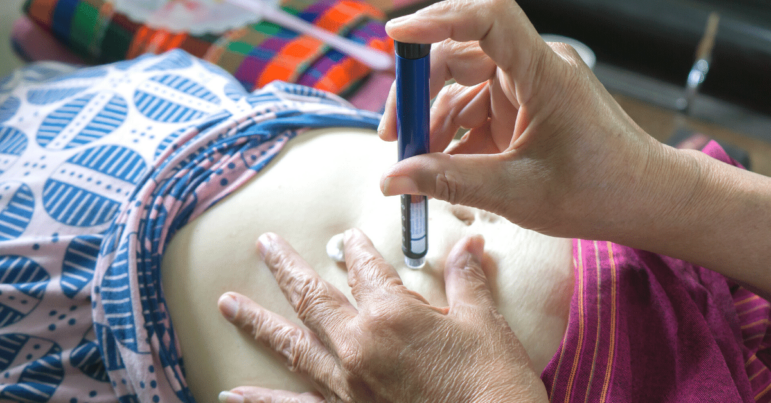For people with type 2 diabetes, tracking their A1c level (a measure of average blood sugar over three months) can be a good way to tell whether their diabetes is under control. However, a recent Reuters investigation offers a cautionary tale of how treatment targets like A1c can be manipulated by drug companies.
In the early 2000s, diabetes advocacy organizations, doctors, government officials, and influential nonprofits started pushing the same message: people with Type 2 diabetes should strive to get their A1c below 7%. Reuters found that this campaign to lower the A1c target was driven largely by pharmaceutical companies, to create a bigger market for their new blood sugar-lowering drugs.
The piece details how insulin-maker Sanofi (then Aventis) led the way in the A1c campaign. They spent millions highlighting the new target in direct-to-consumer advertisements, and gave hundreds of thousands in donations to the American Diabetes Association (ADA) and endocrinologist “thought leaders,” to advance the message. Through their ADA contacts, they also pushed the National Committee for Quality Assurance (NCQA), which develops medical performance measures, to adopt 7% as an A1c target on which doctors could be judged. Other diabetes drug makers soon followed Sanofi’s example.
The result? Sales of diabetes drugs increased ten-fold, from $7.3 billion in 2000 to $74 billion in 2020. At the same time, dangerous side effects due to these drugs have grown. Lowering blood sugar too much can cause hypoglycemia, which can lead to fainting, seizures, and even coma or death. Today, people with diabetes are likely to be hospitalized for low blood sugar than for high blood sugar. Among older adults, who are more susceptible to drug side effects, two-thirds of diabetic emergencies are for hypoglycemic events.
Researchers have seen the impact of blood sugar-lowering drugs, particularly on older adults. A 2019 study by Grace K. Mahoney, MS at the Harvard Medical School and colleagues found that inappropriately intensive treatment of type 2 diabetes leads to thousands of hospitalizations and emergency department visits for low blood sugar each year. They found that between 2011-2014, about 21% of patients with below-average blood sugar levels were treated with medications to further lower their blood sugar, regardless of their age or other chronic conditions. As a result, there were more than 9,500 hospitalizations and ED visits for hypoglycemia over a two-year period due to intensive diabetes treatment. About 8,200 of these events could have been avoided if clinicians had identified the patient as someone at higher risk for hypoglycemia and treated them less intensively.
In the late 2000s and early 2010s, the ADA and NCQA revised their guidelines to make A1c targets more individualized, rather than a “one size fits all” target of 7%. However, direct-to-consumer ads have continued to push the 7% A1c message. “So far this year, seven of the top 10 diabetes TV commercials in terms of dollars spent promote the drug’s ability to lower A1c to less than 7%,” Reuters reports.
The campaign to lower A1c led by Sanofi and other diabetes drugmakers reminds me of Purdue Pharma’s campaign to make pain “the fifth vital sign.” In both cases, medical leaders were influenced by industry donations to reframe medical conditions in ways that promoted more drug use, and to codify this reframing in guidelines. Clinicians and patients both need to recognize the outsized role that industry money plays in shaping messaging and guidelines around treatment targets.
The fact that the role of diabetes drugmakers in crafting a treatment target 20 years ago has only just come to light shows that we need more transparency in the relationships between pharma, medical societies, and advocacy organizations. Even better would be a moratorium on industry payments to doctors and medical societies, coupled with a boost in funding from independent sources.
